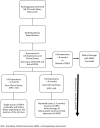Impact of endobiliary radiofrequency ablation on survival of patients with unresectable cholangiocarcinoma: a narrative review
- PMID: 37324013
- PMCID: PMC10266199
- DOI: 10.3389/fonc.2023.1077794
Impact of endobiliary radiofrequency ablation on survival of patients with unresectable cholangiocarcinoma: a narrative review
Abstract
Cholangiocarcinoma (CCA) is a rare cancer originating from the biliary epithelium and accounts for about 3% of all gastrointestinal malignancies. Unfortunately, the majority of patients are not eligible for surgical resection at the time of diagnosis, because of the locally advanced stage or metastatic disease. The overall survival time of unresectable CCA is generally less than 1 year, despite current chemotherapy regimens. Biliary drainage is often required as a palliative treatment for patients with unresectable CCA. Recurrent jaundice and cholangitis tend to occur because of reobstruction of the biliary stents. This not only jeopardizes the efficacy of chemotherapy, but also causes significant morbidity and mortality. Effective control of tumor growth is crucial for prolonging stent patency and consequently patient survival. Recently, endobiliary radiofrequency ablation (ERFA) has been experimented as a treatment modality to reduce tumor mass, and delay tumor growth, extending stent patency. Ablation is accomplished by means of high-frequency alternating current which is released from the active electrode of an endobiliary probe placed in a biliary stricture. It has been shown that tumor necrosis releases intracellular particles which are highly immunogenic and activate antigen-presenting cells, enhancing local immunity directed against the tumor. This immunogenic response could potentially enhance tumor suppression and be responsible for improved survival of patients with unresectable CCA who undergo ERFA. Several studies have demonstrated that ERFA is associated with an increased median survival of approximately 6 months in patients with unresectable CCA. Furthermore, recent data support the hypothesis that ERFA could ameliorate the efficacy of chemotherapy administered to patients with unresectable CCA, without increasing the risk of complications. This narrative review discusses the results of the studies published in recent years and focuses on the impact that ERFA could have on overall survival of patients with unresectable cholangiocarcinoma.
Keywords: ERCP; PTC; biliary drainage; biliary stent patency; cholangiocarcinoma; endobiliary radiofrequency ablation; malignant biliary strictures; overall survival.
Copyright © 2023 Di Girolamo, Belli, Ottaiano, Granata, Borzillo, Tarotto, Tatangelo, Palaia, Civiletti, Piccirillo, D’Angelo, Fiore, Marone, Nasti, Izzo and de Bellis.
Conflict of interest statement
The authors declare that the research was conducted in the absence of any commercial or financial relationships that could be construed as a potential conflict of interest.
Figures


References
-
- Pantano F, Iuliani M, Simonetti S, Tonini G. Colecisti e vie biliari. In: Airtum, I numeri del cancro in italia (2021). AIOM (Intermedia Editore; (2021). p. 55–6. Available at: https://www.aiom.it/wpcontent/uploads/2021/10/2021_NumeriCancro_web.pdf.
-
- O’Brien S, Bhutiani N, Egger ME, Brown AN, Weaver KH, Kline D, et al. . Comparing the efficacy of initial percutaneous transhepatic biliary drainage and endoscopic retrograde cholangiopancreatography with stenting for relief of biliary obstruction in unresectable cholangiocarcinoma. Surg Endosc (2020) 34(3):1186–90. doi: 10.1007/s00464-019-06871-2 - DOI - PubMed
Publication types
LinkOut - more resources
Full Text Sources

